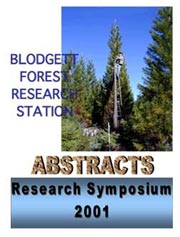Nitrogen oxide radicals (NOx = NO + NO2) are important in regulating tropospheric ozone. Outside of urban source regions, NOx is stored in reservoirs (known as NOy) that include HNO3, peroxynitrates (RO2NO2), and alkylnitrates (RNO3). Formation of these species terminates the catalytic cycles that produce ozone via oxidation of NO to NO2. The reservoirs are then deposited to the Earth’s surface or transported out of the formation region to the remote atmosphere, where NOx can be released photochemically to restart the catalytic production of ozone. Increases in export of NOx to the remote atmosphere is thought to be responsible for the three-fold increase in tropospheric ozone that has occurred since pre-industrial times. A detailed knowledge of the concentration of these reservoirs is necessary in order to test the accuracy of our understanding of NOx photochemistry and to predict the effects of regional scale processes, such as those occurring at Blodgett Forest, on local and on global ozone concentrations. However, there are currently no techniques capable of rapid, precise and accurate observation of all of the NOy species. We have developed a prototype instrument that uses a new approach to obtain in situ observations of the concentrations of the four major NOy reservoirs with high accuracy, precision and sensitivity (15ppt/10 seconds). In our instrument, ambient air passes through a heated quartz tube where the NOy species are thermally dissociated to produce NO2 which is then detected by laser induced fluorescence. Each of the four categories of NOy reservoirs decompose at different temperature. We measure the abundance of the sum of compounds corresponding to each category by varying the temperature in the dissociation region. This technique has been employed at Blodgett Forest in Fall 1999 and Fall 2000 demonstrating its capabilities for autonomous, continuous observation of an array of NOy species. A discussion of the instrument and the preliminary data from the field measurements at Blodgett Forest will be presented.
|

